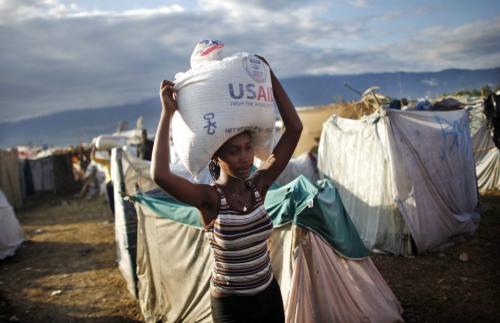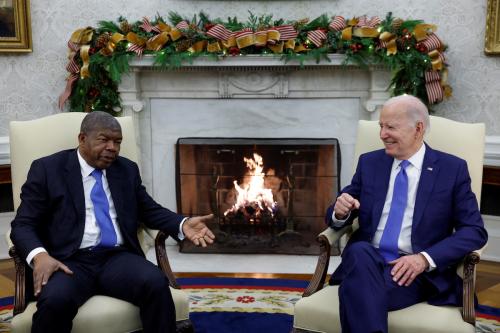When President Donald Trump released his proposed budget earlier this year, policymakers on the left and right criticized his cuts to foreign aid and declared them a non-starter. Foreign aid, many lawmakers said, is a form of soft power, helping the United States achieve its interests in the world without resorting to more forceful tactics. The Bill and Melinda Gates Foundation also responded to the proposed cuts, noting that aid saves the lives of children, decreases poverty, and is crucial to fighting disease.
Same instrument, changing objectives
The current aid debate brings up questions that have not been given much attention outside of policy circles. What is the purpose of development aid, and has it changed over time? Is aid spending about spurring development, or is it about advancing the interests of the donor? In a new article published in International Organization, I argue that donor governments increasingly see development promotion as an exercise in self-interest. That is, donors use aid to encourage development that is in their own interest.
In a connected world, policymakers in wealthier countries believe that transboundary problems such as terrorism, unwanted migration, spread of disease, regional instability, crime, gang violence, and trafficking in persons and illicit substances are exacerbated by underdevelopment. Donor states, unable to insulate themselves from negative spillovers emanating from developing countries, are altering aid policy in an attempt to mitigate problems in the source countries. The result is an increase in the development intent associated with aid spending.
This change was championed by politicians in donor nations. When defending his government’s unpopular increases in foreign aid, former United Kingdom Prime Minister David Cameron claimed that it is “in our interests that we build a more prosperous world. If we don’t, the problems of conflict, the problems of mass migration, the problems of uncontrollable climate change are problems that will come and visit us at home.” President George W. Bush made similar claims when announcing new programs such as the Millennium Challenge Account and President’s Emergency Plan for AIDS Relief, which significantly increased U.S. aid flows. Policy documents from donors such as Switzerland and Japan also include self-interested rationale for promoting development abroad.
Self-interested development strategies have resulted in big changes in the way aid is allocated across recipients. During the Cold War, aid was often used to project the donor’s influence in far away countries; to help strategically important states regardless of development impact. Britain’s former Secretary of State for International Development Hilary Benn has noted that Cold War aid often did not focus on development, and was “provided to dictators just because they were on ‘our side.’” Along the same lines, foreign aid expert Steven Radelet argues that no one ever thought Mobutu was using aid “to vaccinate children or train teachers” in the 1980s.
After 2001, a shift to poor, proximate, and populous countries
Since the end of the Cold War, and particularly following the terrorist attacks of September 11, 2001, a pro-development shift in aid policy was observed. Examining aid from 23 donors to 156 recipients, I found a post-9/11 focus of foreign aid on poor, proximate, and populous countries. The pattern of aid allocation changed significantly from the Cold War, when donors often used aid to support militarily important states or buy influence in small, sometimes distant, countries. Aid in the post-9/11 period disproportionately flows to countries that send more migrants to and trade more with the donor. Military importance is still associated with greater aid, but much less so than during the Cold War. The pattern is consistent with an increased focus on development concerns in countries that present high risk of spillovers to a donor.
Donors are responsive to the quality of governance in recipient countries in recent years. Where governance is poor, donors are more likely to allocate aid to sectors where non-government organizations are important providers of aid. This suggests that donors are altering the composition of aid to account for differences in government capacity or the willingness to pursue development, in an attempt to increase the impact of foreign assistance. Again, this marks a change: There is no evidence of responsiveness to governance during the Cold War.
Past performance is a poor guide to future aid effectiveness
The shifting patterns of aid allocation have implications for studying aid effectiveness. Changing donor motivations mean that past outcomes may be a poor guide to predicting current and future effectiveness. Perhaps donors will prove ineffective at promoting development, even when their motives have shifted in that direction. Perhaps aid agencies of the past, many of them relics of the Cold War, will be insufficiently nimble and unable to adjust to new objectives. Or perhaps aid will adapt to this new role, leading to improved development outcomes.
There is an important caveat to this increased attention to development: Donors are disproportionately focusing their aid where it will most help themselves by reducing spillovers associated with underdevelopment. Naturally, not every country will be equally targeted for this assistance. This is particularly problematic because the analysis shows that less favored states are already some of the least connected. States benefiting less from trade and migrant remittances are likely to receive less aid, leading to a widening gap between those developing quickly and those left behind.
A likely outcome is growing discontent, suggesting that harmful spillovers from these countries will be partially a result of self-interested development strategies that today are largely excluding them.







Commentary
Not your parents’ foreign aid: The shift from power to proximity and poverty
September 20, 2017